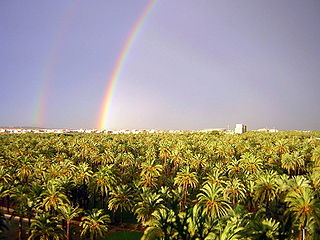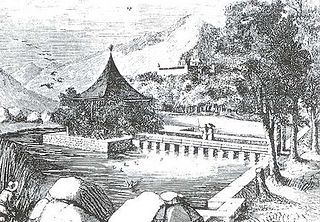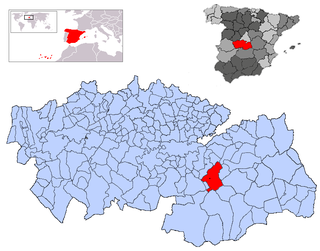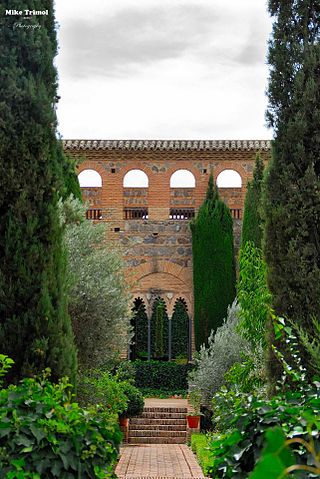Related Research Articles

Toledo is a city and municipality of Spain, the capital of the province of Toledo and the de jure seat of the government and parliament of the autonomous community of Castilla–La Mancha.

Murcia is a city in south-eastern Spain, the capital and most populous city of the autonomous community of the Region of Murcia, and the seventh largest city in the country. It had a population of 460,349 inhabitants in 2021. The total population of the metropolitan area was 672,773 in 2020, covering an urban area of 1,230.9 km2. It is located on the Segura River, in the southeast of the Iberian Peninsula. It has a climate with hot summers, mild winters, and relatively low precipitation.

Castilla–La Mancha is an autonomous community of Spain. Comprising the provinces of Albacete, Ciudad Real, Cuenca, Guadalajara and Toledo, it was created in 1982. The government headquarters are in Toledo, which is the capital de facto.
A huerta or horta, from Latin hortus, "garden", is an irrigated area, or a field within such an area, common in Spain and Portugal, where a variety of vegetables and fruit trees are cultivated for family consumption and sale. Typically, individual huertas belong to different people; they are located around rivers or other water sources because of the amount of water required, which is usually provided through small canals (acequias). They are a kind of market garden.

The Palmeral or Palm Grove of Elche is the generic name for a system of date palm orchards in the city of Elche, Spain.
Torrijos is a municipality in the province of Toledo, Castilla–La Mancha, Spain. As of 1 January 2022, it had a registered population of 13,678. The municipality spans across a total area of 17.34 km2.

Alcaraz is a municipality of Spain located in the province of Albacete, Castilla–La Mancha. The municipality spans across a total area of 370.53 km2. The locality lies at 953 metres above mean sea level.
Yepes is a villa (town) in the northern region of the province of Toledo, in the autonomous community of Castile-La Mancha, Spain.

La Fresneda is a park in El Escorial, Community of Madrid, Spain. Built between 1561 and 1569, it was the private Royal Park of Philip II in the surroundings of the Monastery of El Escorial.

Spanish Gothic architecture is the style of architecture prevalent in Spain in the Late Medieval period.

Garciotum is a municipality of Spain located in the province of Toledo, Castilla–La Mancha. The municipality spans across a total area of 22.73 km2 and, as of 1 January 2023, it has a registered population of 215.

Huerta de Valdecarábanos is a municipality located in the province of Toledo, Castile-La Mancha, Spain. According to the 2006 census (INE), the municipality has a population of 1,784 inhabitants.

El Puente del Arzobispo is a municipality of Spain located in the province of Toledo, Castilla–La Mancha. The municipality spans across a total area of 0.98 km2 and, as of 1 January 2020, it has a registered population of 1,225. Together with neighbouring Talavera de la Reina, El Puente del Arzobispo was a producing centre of Maiolica pottery in Early-Modern Spain.

Mora is a town and municipality in Toledo province, in the autonomous community of Castile-La Mancha, Spain. The area is most famous for the abandoned ruins of the San Marcos de Yegros monastery of the Order of Santiago, located northeast of the town of Mora about 10 km on the Calle de los Dolores in the village of Paraje de Yegros.

Rodrigo Jiménezde Rada was a Roman Catholic bishop and historian, who held an important religious and political role in the Kingdom of Castile during the reigns of Alfonso VIII and Ferdinand III, a period in which the Castilian monarchy consolidated its political hegemony over the rest of polities in the Iberian Peninsula. He was at the helm of the Archdiocese of Toledo from 1208 to 1247. He authored De rebus Hispaniae, a history of the Iberian Peninsula.

The Palacio de Galiana is a Mudéjar palace in Toledo, Spain, on the borders of the Tagus River. It was built on the site of an earlier summer villa and garden of Al-Mamun, the king of the Taifa of Toledo, in the thirteenth century by king Alfonso X of Castile.

David Huerta was a Mexican poet and the son of well-known poet Efraín Huerta. His wife was the writer Verónica Murguía.
Guaitil is a district of the Acosta canton, in the San José province of Costa Rica.

The Palacio de la Ribera was the summer residence of Philip III in Valladolid. It was built in the 17th century (1602-1605) as part of a process of urban transformation upon the establishment of the Spanish Court in Valladolid between 1601 and 1606. The palace was situated at the Huerta del Rey neighborhood, located across the Parque de las Moreras on the right bank of the Pisuerga river. The palace grounds extended from the Puente Mayor to Ribera de Don Periáñez del Corral and delimited at both sides by the Pisuerga river and the Camino del Monasterio del Prado. The palace was gradually abandoned until it became part of the destroyed cultural heritage of Valladolid in 1761. Some ruins of the building are still preserved.
In the run up to the 2015 Spanish local elections, various organisations carried out opinion polling to gauge voting intention in local entities in Spain. Results of such polls for municipalities in Castilla–La Mancha are displayed in this article. The date range for these opinion polls is from the previous local elections, held on 22 May 2011, to the day the next elections were held, on 24 May 2015.
References
- ↑ Mariano Calvo, "Cuando Toledo era Greenwich", in: Tulaytula: Revista de la Asociación de Amigos del Toledo Islámico, ISSN 1575-653X, Nº. 1-2, 1997/1998, p.50